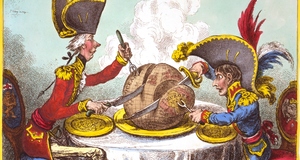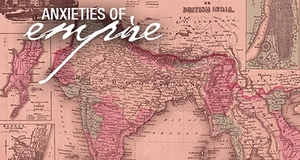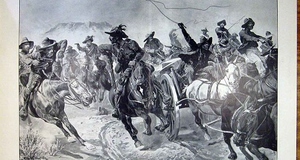Breaking Boundaries: Football and Colonialism in the British Empire
By
2009, Vol. 1 No. 11 | pg. 2/2 | « With the exception of Lopez's article, many of these works seem to share a central theme. Football as a unifying force that ultimately brought together colonized nations and provided an outlet though which resistance could be waged. Not only was football adopted and used in resisting but it was infused with cultural elements that made it distinct to each area. Football in colonial Zanzibar is a textbook example of resisting through football. Fair's article describes how football's ability to overcome social division was rooted in indigenous dance. “While these dance organisations often reflected existing social divisions, some groups provided opportunities for bridging class and ethnic cleavages.”9 Using cultural cues to create their own sense of the game was not solely Zanzibari. Boria Majumdar writes that a central part of Indian pride came through playing football barefoot. “The virtual universality of masculine sport in colonial India went hand in hand with its cultural indigenization.”10Playing barefoot was not only a way to make football distinctly Indian, but it helped unite those who played. As in Zanzibar, South Africans linked football with dance for not only its participants, but for those spectating; establishing the “profound connections between sport, music, dance, and liquor in South African popular culture.”11 While many of the articles reach similar conclusions about the process of resisting through football the approaches are quite unique. Fair concentrates on the back and forth struggle of control that the British faced in colonial Zanzibar and the importance of boycotting biased referees which reinforced the colonized's power play. Though Alegi's article also deals with an African nation it focuses on establishing the history of legislature that forms a foundation of oppression for South Africans to unite and fight against. The two articles on India deal with similar themes of unity and resistance yet focus on different aspects of its history. Majumdar's article more generally argues the unifying force of football in India, citing how football allowed Indians to battle stereotypes of effeminacy as well as its adaptation to indigenous culture by playing barefoot. Bandyopadhyay chooses to focus on the events of 1911 as a microcosm of the role of football. Ultimately Bandyopadhyay and Majumdar reach similar conclusions but through different means. By approaching these questions of resistance through different lenses it offers a more thorough understanding of the complex situation. Yet it is interesting that the articles find the same basic conclusions. Football creates resistance through its ability to unify and create challenges. However, the articles do seem to neglect potential key aspects, sometimes only hinting at their role. Firstly, many of the articles mention spectating, yet do not seem to evolve it's role in the resistance movement. Spectating creates the ability for everyone to become a part of the match. The match was the culmination of resistance for each team, each nation. The direct symbolism of matches could not be lost on the spectators who witnessed it and without spectatorship the results of these matches would not have been felt so universally, both for colonizer and colonized. Another gap seems to be a lack of information on the point of view of the colonizer. The importance of these matches could not have been lost on the colonizer. Were the effects felt in Britain? What stake did the British people have in beating the colonizer? The fact that the articles arrive at similar conclusions is almost a letdown. It feels as if something is missing. Though Bandyopadhyay's article mentions the possibility that the importance of these matches to the colonized would somehow be regarded as a success by the British, he concludes, and I agree that this is most likely a flawed argument. The notion that the British would find anything but shame in losing to those who they colonized at their own game is hard to buy, yet the notion of another viewpoint is interesting, if for no other reason then it makes one wonder about other interpretations of resistance through sport in the empire. Finally there is Lopez's article. It almost seems misplaced in this collection. A postcolonial study among colonial ones. Yet while the other articles argue unity and resistance by including important indigenous values, Lopez illustrates how the Egyptians resist against their own flawed history. Egypt's desire to win seems rooted not in a desire to gain independent status but to become one of the the colonizers. Egypt's success is marked in whether or not it was seen belonging to a European class, a modern state, devoid of the backwards notions typically attributed to 'non-Western nations'. Ultimately, Egypt's story can be compared to those of Zanzibar, South Africa, and India. All attempts to break out of an inferior mold cast upon them so many decades ago. Football served this purpose well. Allowing direct competition and symbolic matches that signified the political and social struggles at the time. The difference between Lopez's article and the other articles remains the ultimate goal of resistance. Endnotes1.) Fair, Laura. "Kickin' It: Leisure, Politics and Football in Colonial Zanzibar, 1900s-1950s." Africa: Journal of the International African Institute 67, no. 2 (1997): 224-251. 2.) Ibid 3.) Ibid 4.) Ibid 5.) Ibid 6.) Alegi, Peter C.. "Playing to the Gallery? Sport, Cultural Performance, and Social Identity in South Africa, 1920s-1945." The International Journal of African Historical Studies 35, no. 1 (2002): 17-38. 36 7.) Bandyopadhyay,Kausik. Sport in South Asian Society: Past and Present. Boria Majumdar and J.A. Mangan. London: Routledge, 2005. 39 8.) Lopez, Shaun. "Football as National Allegory: Al-Ahram and the Olympics in 1920'Egypt." https://faculty.washington.edu/stlopez/History466 (accessed 12.06.2008). 9.) Fair, Laura. "Kickin' It: Leisure, Politics and Football in Colonial Zanzibar, 1900s-1950s." 10.) Majumdar, Boria. 2006. "Tom Brown goes global: The 'Brown' ethic in colonial and post-colonial India". International Journal of the History of Sport, 23:5, 805-820. 11.) Alegi, Peter C.. "Playing to the Gallery? Sport, Cultural Performance, and Social Identity in South Africa, 1920s-1945." The International Journal of African Historical Studies 35, no. 1 (2002): 17-38.
Suggested Reading from Inquiries Journal
Inquiries Journal provides undergraduate and graduate students around the world a platform for the wide dissemination of academic work over a range of core disciplines. Representing the work of students from hundreds of institutions around the globe, Inquiries Journal's large database of academic articles is completely free. Learn more | Blog | Submit Latest in History |


















